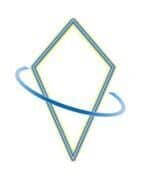Particle Model
Electron Model
The geometry of the wave-field in Field-Space-Mechanics provides the particle model with a powerful modeling platform for arbitrarily complex hollow body vibrations. Subatomic structures are calculated as a product of harmonics. Each harmonic thus describes a part of the overall geometric arrangement of a particle. This part is called the quark excitation frequency, and it is only through their combination that the diverse particle structures arise, some of which have been determined by experiments and can now be predicted. The particle folder summarizes various known and newly predicted particles. It uses the general formula to determine all particle excitation frequencies. Among other things, this formula ensures that a distinction can be made between electrical, strong, and weak interactions.
The following illustration shows how this bundle of fions in the form of a positron rotates within the sphere. On the left, you can see the geometry that makes the positron detectable within the particle-field. On the right, the same positron is lifted from its point of contact with the particle-field on the dimensional plane D56, resulting in a hidden (dark matter) positron.

The simulation shows the space-time dynamic behavior of the positron. The same applies to the electron, which is located below the dimension plane D56 . The bundle changes direction every period T because the sphere assumes its own relativistic dynamics in space-time to create a field that emerges from a “resting” electromagnetic hollow body vibration. This complex dynamic creates the maximum field at the point of contact, which is transmitted into the particle-field. After a period of 2T, the red star indicates the moment of this field exchange, when all fions arrive at this point of contact synchronously with the sphere. The rotation of the particle and each fion proceeds at half the maximum speed c/2. With this geometry, angular momentum, resulting rotational speeds, iso-spins, the Pauli principle, and thus the interaction of fields and coupling possibilities between particles can be explained.
Simulation:

Attraction between charges
Particles with different charges attract each other if
a) their exchange fions rotate in the same direction and can fuse with the respective recipient particle, and
b) the active fions of both particles rotate in the same direction above and below the dimensional plane D56.

Repulsion between charges
Particles with the same charge repel each other if
c) the exchange fions rotate differently and thus ignore each other, and
d) the active fions rotate in the same direction with their subspaces in sphere S.

Destructive reaction between charges
An annihilation reaction requires a specific spatial structure between two differently charged particles.
e) The active fions from an electron rotate below and the active fions from a positron rotate above the dimensional plane D56.
f) The rotation of their spheres S takes place antiparallel to the dimensional plane D46.
g) These two particles come too close to each other and meet at their respective point of contact in such a way that their fions are exactly or almost exactly in phase at the respective point of contact.

Mesons consist of two bosons, which in turn consist of a quark and an exchange fion. The quarks supply a fion from their bundle to produce an exchange fion. Depending on the interaction with other particles, the total charge can drop from 3/3 to 2/3 or even to 1/3. The exchange fion rotates outside the boson at the maximum speed c. The distance to be overcome depends on how long a fion must rotate so that all its fions and its sphere S are synchronized at the point of contact with the receiving boson. After migrating from one meson to the other, its field exchanges with the particle-field during the recombination phase in the boson. The momentum with its field is mediated at the point of contact in the dimensional plane D56. The strong interaction and a mass in the particle-field are registered.
Simulation:


Simulation:



Simulation:


Particle structure of mesons and baryons
Particle-exchange Fion-Particle-Coupling

- fobj – coupling frequency for arbitrary objects
- Mobj – mass for arbitrary objects
- 1/2 – for half the speed of a bound exchange fion relative to an unbound exchange fion in a particle-exchange fion-particle coupling
- BC – boson configurationn
- CC – coupling configuration
- Power of three for the three possible fions that can be disturbed from the particle field
- n – nth dimensional family
- PC – particle configuration
- Dimfactor for reducing the maximum speed c
- Me – mass of the electron
- fe – frequency of the electron

BC - Boson Configuration
BC counts all fions in the bundle in the numerator and additionally counts fions received for a limited time in sphere S. The maximum possible number of fions in the bundle is counted in the denominator.

CC - Coupling Configuration
CC summarizes the maximum possible number of fions in the bundle in the numerator. In contrast, the denominator shows the number of periods T required to generate synchronization between the bundle fions and the sphere S.
PC - Particle Configuration
PC – describes common particle types such as mesons, baryons, electrons, or free fions. In the numerator, the fions in the bundle are counted, plus externally received fions, minus all fions required to produce the required exchange fions. The maximum number of bundle fions remains in the denominator.
Excerpt from the particle folder
Selected particles measured in experiments are presented below. When the mean value from the experiments is compared with the theoretically calculated value without taking the standard deviations into account, there is only an average deviation of 1% between them. The source is the Particle Data Group (PDG).

Mass Muon

Mass Pion

Mass Proton/Neutron



